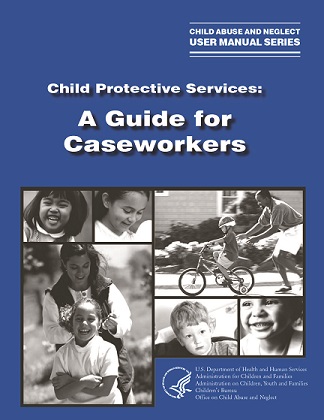Child Protective Services: A Guide for Caseworkers
About The Authors Diane DePanfilis, Ph.D., M.S.W., is Associate Professor
of Social Work at the University of Maryland,
Baltimore, where she teaches social work practice
and child welfare research courses in the Master’s
of Social Work program and research seminars in
the doctoral program. She is also codirector of the
Center for Families, an interdisciplinary partnership
between the schools of social work and medicine and
the department of pediatrics. Over the past 30 years
she has provided child welfare services at the local
level as a caseworker, supervisor, and administrator;
worked as a consultant at the national level
conducting program evaluations and providing
training and technical assistance to social workers
and other disciplines; and conducted extensive
studies related to the delivery of child protective
services and the prevention of child maltreatment.
She is coeditor of the Handbook on Child Protection
Practice and is a former president of the American
Professional Society on the Abuse of Children.
Marsha K. Salus, M.S.W., is a social work consultant.
She has worked in the child welfare field for 27
years. She began her career as a CPS worker and
supervisor. She has developed several national
curricula for child welfare workers and supervisors.
She developed a number of preservice and inservice
training programs for child welfare workers and
supervisors in a variety of States. For example,
Ms. Salus developed a 12-day core supervisory
training program entitled “Mastering the Art of
Child Welfare Supervision,” which she has delivered
throughout the country. In addition, she has
provided training on all aspects of family violence
to multidisciplinary audiences around the country.
Ms. Salus has assisted State and local CPS agencies in
program development and program evaluation and
has worked with several States to establish standards
of practice for child welfare supervision.
Course Description Each day, the safety and well-being of some
children across the Nation are threatened by
child abuse and neglect. Intervening effectively
in the lives of these children and their families is
not the sole responsibility of any single agency or
professional group, but rather is a shared community
concern
Since the late 1970s, the Child Abuse and Neglect
User Manual Series has provided guidance on
child protection to hundreds of thousands of
multidisciplinary professionals and concerned
community members. The User Manual Series
offers a foundation for understanding child
maltreatment and the roles and responsibilities of
various practitioners in its prevention, identification,
investigation, and treatment. Through the years,
the manuals have served as valuable resources for
building knowledge, promoting effective practices,
and enhancing community collaboration.
Since the last update of the User Manual Series in
the early 1990s, a number of changes have occurred
that dramatically affect each community’s response
to child maltreatment. The changing landscape
reflects increased recognition of the complexity of
issues facing children and families, new legislation,
practice innovations, and systems reform efforts.
Significant advances in research have helped shape
new directions for interventions, while ongoing
evaluations help us to know “what works.”
The Office on Child Abuse and Neglect (OCAN)
within the Children’s Bureau of the Administration
for Children and Families (ACF), U.S. Department
of Health and Human Services (DHHS), has
developed this third edition of the User Manual
Series to reflect our increased knowledge and the
evolving state of practice on child protection. The
updated and new manuals are comprehensive in
scope while also succinct in presentation and easy
to follow, and they address trends and concerns
relevant to today’s professional.
This manual, Child Protective Services: A Guide for
Caseworkers, examines the roles and responsibilities
of child protective services (CPS) workers, who
are at the forefront of every community’s child
protection efforts. The manual describes the basic
stages of the CPS process and the steps necessary
to accomplish each stage: intake, initial assessment
or investigation, family assessment, case planning,
service provision, evaluation of family progress,
and case closure. Best practices and critical issues
in casework practice are underscored throughout.
The primary audience for this manual includes
CPS caseworkers, supervisors, and administrators.
State and local CPS agency trainers may use the
manual for preservice or inservice training of CPS
caseworkers, while schools of social work may add
it to class reading lists to orient students to the field
of child protection. In addition, other professionals
and concerned community members may consult
the manual for a greater understanding of the child
protection process.
This manual builds on the information presented
in A Coordinated Response to Child Abuse and
Neglect: The Foundation for Practice. Readers are
encouraged to begin with that manual as it addresses
important information on which CPS practice is
based—including definitions of child maltreatment,
risk factors, consequences, and the Federal and State
basis for intervention. Some manuals in the series
also may be of interest in understanding the roles
of other professional groups in responding to child
abuse and neglect, including:
• Substance abuse treatment providers
• Domestic violence victim advocates
• Educators
• Law enforcement personnel.
Other manuals address special issues, such as
building partnerships and working with the courts
on CPS cases.
Learning Objectives After completing this course you’ll be able to:
1. Describe the basic stages of the Child Protective Services (C.P.S.) process and the steps necessary to perform essential casework functions.
2. Discuss the philosophical basis on which C.P.S. is founded.
3. Explain the relationship between C.P.S. and other community agencies and professionals.
4. Compare the “helping relationship” and the use of authority in working with children and families.
5. List some of the factors contributing to, and resulting consequences of, child abuse and neglect.
6. Demonstrate the importance of effective documentation when involved with case records, information systems, and related legal documents.
7. Describe strategies for casework supervision, training, consultation, and support.
8. Discuss how various community organizations can work together to better protect children and their families.
